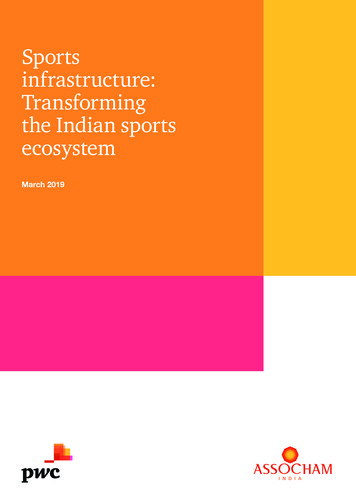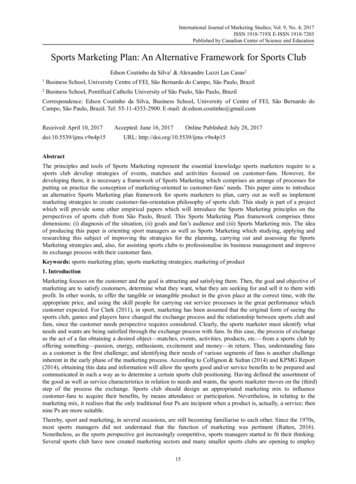
Transcription
Sportsinfrastructure:Transformingthe Indian sportsecosystemMarch 2019
Table of contents1. From the President’s desk42. Foreword53. Message from PwC64. Executive summary75. Sports infrastructure: Backbone of the sports ecosystem86. Impact of quality sports infrastructure147. Key challenges for developing sports infrastructure178. Key recommendations189. Conclusion202 PwC Sports infrastructure: Transforming the Indian sports ecosystem
From thePresident’sdeskB. K. GoenkaPresidentASSOCHAMInfrastructure is the backbone of sports. Severalempirical studies have established sports as a beneficialactivity having a positive impact on the state of health,education and the economy. The United NationsEducational, Scientific, and Cultural Organisation(UNESCO) recognises the practice of sports and physicaleducation as a fundamental right for any human being.Realising the benefits of sports in general and sportsinfrastructure in particular, nations such as China,Australia, and the United States have invested heavilyin related infrastructure. For instance, China, as partof its National Fitness Program, started investing insports infrastructure in 1995. Australia has focused ongrass-roots development by building community sportsinfrastructure. Sports Australia reports USD 16.2 billionworth of social, health and economic benefits each yearthrough community sports infrastructure. The UnitedStates has tightly integrated sports infrastructure intoits education system by providing athletics with facilitiesacross schools, colleges and universities. This hashelped these nations become global sporting powers.India has witnessed a spurt of growth in sportsinfrastructure development in recent years, which willhave a strong impact on the state of sports in the longrun. Challenges such as availability of land bank andineffective utilisation of existing infrastructure pose ahindrance to this growth. Sports infrastructure shouldbe treated as an integral part of urban planning so thatadequate resources are budgeted for developmentand sustenance. It should be designed keeping a largecommunity in mind, which can increase utilisationand ensure steady revenue streams. Policy supportfrom the government will also benefit investment intosports infrastructure via the public-private-partnership(PPP) model.This ASSOCHAM-PwC publication titled ‘Sportsinfrastructure: Transforming the Indian sportsecosystem’ is a step towards highlighting theimportance of sports infrastructure in the Indian sportsindustry. It presents a view of the current scenario andoffers recommendations that can help build stronginfrastructure in the country.We believe this publication will help multiple stakeholderstake a fresh look at the challenges and opportunities tosports infrastructure development and enable them totake positive steps towards transforming this sector.3 PwC Sports infrastructure: Transforming the Indian sports ecosystem
The passion for sports in India is unparalleled. Whilecricket continues to dominate the field, several othersports like football and basketball are gaining ground.Sports infrastructure is vital to the growth and expansionof sports in India as we aspire to host mega sportingevents and world cups in the future. It is equally importantto improve sports infrastructure in India in order to developbudding talent and empower competitive athletes in thecountry.ForewordPresently, India has a growing population keen onwitnessing and participating in sports and sporting events.It is therefore important to expand the capabilities andquality of sporting facilities and stadiums to accommodateand encourage this demand, keeping in mind thecommunity, sports development, and economic impact.This ASSOCHAM-PwC knowledge paper titled ‘Sportsinfrastructure: Transforming the Indian sportsecosystem’ provides a holistic view of the status of sportsinfrastructure in the country. While there has been policysupport from the government to enable the developmentof sporting facilities, we also look at private contributionsand corporate partnerships in the sector. With theintegration of ‘everything digital’ in this age, we considerthe different kinds of research enabling the evolution ofsports and the ways in which digital advancements havechanged sports infrastructure. This publication focuses onthe different economic, social and developmental benefitsof improving sports infrastructure to the community. It alsoprovides recommendations and suggests the way forwardfor sports infrastructure development in India.Uday Kumar VarmaSecretary GeneralASSOCHAMIt is our privilege to release this knowledge paperat ASSOCHAM’s National Summit & Awards forSports Business – Infrastructure, Investment andMerchandising on 28 March 2019 at Shangri-La’s Eros,New Delhi, which aims to bring together a multitudestakeholders—from manufacturers and distributors tolarge sporting organisations and governing bodies—tocreate a platform for sportsmen and sports development.We recognise and appreciate the efforts and contributionof ASSOCHAM team and PwC in publishing this reportand organising the summit. We believe the outcomesof this conference as well as our knowledge paper willserve as an important reference point for the variousstakeholders who are working towards improving thestate of sports in the country and levelling up India in thecompetitive global sporting landscape.4 PwC Sports infrastructure: Transforming the Indian sports ecosystem
Messagefrom PwCRaman KalraPartner and Leader, Media, Entertainmentand Sports AdvisoryShivanshu ChauhanPartner and LeaderUrban InfrastructureSports make up a global language understood acrosscastes, creeds and races. Therefore, when the Brazilianfootball team scores, even a fan in Kolkata celebrates. Asport is the simplest form of expression, displaying thetenacity and persistence of the human spirit. Moreover,sports play a significant role in the transformation ofcommunities, societies and nations. In fact, the UnitedNations has even identified sports as an importantenabler for sustainable development.The Indian sports industry is growing rapidly, presentinggrowth opportunities to all the stakeholders of thesports ecosystem. We are witnessing profound interestfrom the government and the private sector, which hashelped strengthen the image of sports within the country.The success of our sportspersons in the internationalarena, increased investment in non-cricketing sports,and a competitive structure in the form of leagues haveadded to the popularity of sports. It is the right time torally behind sports as a priority sector and consider thepotential impact of quality infrastructure on their growth.Proper infrastructural support has an impact on thedevelopment of elite sports talent and sports participationat the grass-roots level. Having said that, developmentand maintenance are dependent on large investment,policy support and technical expertise. Although Indiahas started investing aggressively in sports infrastructure,it has a long way to go. The designation of specialsports zones across key parts of the nation can enablededicated resources to be utilised for the developmentof sports in the country, taking it to newer heights. Thisdesire to empower sports is reflected in India’s globalvision as well. NITI Aayog, in its action plan ‘Let’s Play- AnAction Plan to achieve 50 Olympic Medals’, has mademultiple recommendations for sports infrastructuredevelopment, such as development of infrastructurethrough the private or PPP mode, hosting of internationalevents at regular intervals, and devotion of a fixed portionof school expenditure towards maintaining and enhancingsporting infrastructure and equipment.We are pleased to present this publication, whichattempts to explore the state of sports infrastructure, itsimpact on sports development and the sports ecosystemfrom an Indian context. The report presents insights thatwill open channels for progressive discussions on thiscritical topic.We would like to thank ASSOCHAM for providing uswith the opportunity to serve as the knowledge partnerfor the National Summit & Awards for Sports Business– Infrastructure, Investment and Merchandising’, amajor platform for bringing together sports industrystakeholders.5 PwC Sports infrastructure: Transforming the Indian sports ecosystem
ExecutivesummarySports in any country are part of a complex ecosysteminvolving athletes, sports fans, leagues, privatecompanies, government bodies and regulatory authorities.All of these stakeholders play an important role in thedevelopment of sports in the country.When perfectly aligned, these different players have thepotential to drive India’s standing on the global sportingstage by offering high-quality facilities and resources thatsustain the love for sports in the country and supportthe hosting of large sporting events. However, if thesestakeholders do not work in synchronisation, there ispotential for stagnation and decline in the quality of sportswithin the nation.In this paper, the importance of improving and buildingsports infrastructure is discussed along with thevarious roles and contributions of the above-mentionedstakeholders. The paper also discusses the challengesthat India may be confronted with in its quest to becomea sporting superpower: lack of infrastructure planning,underutilisation of current infrastructure and poormaintenance of sporting facilities in major cities, as wellas the complex guidelines for the allocation of sportsfunds and implementation of sports policies. Outdatedtechnology and a dearth of smart stadiums have alsohampered the development of sports in the country.Considering the widespread impact sports have on theeconomy and community of a nation and the integral roleplayed by sports infrastructure in the growth of sports,a dedicated approach to infrastructure development iswarranted.India has a promising economy with a thriving middleclass that has the capacity and desire to spend on,participate in and support sports. As the country looksto host more mega sporting events, having successfullyhosted the U-17 FIFA World Cup, Men’s Hockey WorldCup, and the Commonwealth Games, it is necessary for allstakeholders to truly invest in the nation’s relationship withsports. With better guidelines for PPPs, legislation thatbrings the various sports authorities under one roof andincreased accessibility to quality sporting facilities at thelocal level, India has the potential to become a formidablesporting nation.6 PwC Sports infrastructure: Transforming the Indian sports ecosystem
Sports infrastructure: Backboneof the sports ecosystemBackgroundSports is globally identified as a catalyst for economicdevelopment and a separate sector to be administeredin various economies. The sector includes sportingevents and infrastructure associated with sports, alongwith training facilities and sports retail. Manufacturing ofsports goods also forms a major part of the sector. As it isclosely linked with various other sectors like tourism, realestate and health education, the sports sector as a wholeimpacts the global economy significantly.Sports infrastructure has been defined as “the primaryphysical and organisational construction needed tofacilitate sport participation. From a functional point ofview, sports infrastructure enables community membersto participate in sports”.1 It comprises facilities, systems,goods, and services that enable sports and is vital forany country to compete in the international sportingarena. Sports infrastructure assists in the developmentof world-class athletes and also provides impetus to theyouth of the nation to actively take up sports and build asports culture.2and competitions only. As a result, the occupancyrates of the facilities remain low and they are financiallydependent on the regulatory authorities for operationsand maintenance. This also has an adverse effect onsports enthusiasts, who could have made efficient use ofsuch facilities.Recently, India witnessed massive growth of franchisebased sporting leagues, with 10 leagues existing in thecountry. Government initiatives like Khelo India haveinspired many potential individuals to take up sports. Tosustain this growth momentum in sports, there is a needto increase the number of sporting facilities with worldclass infrastructure, which will enable the government toachieve its vision of 50 Olympic gold medals soon.3 As afirst step, identification and consolidation of informationon existing sporting facilities need to be undertaken tohelp upgrade and refurbishment. These facilities canthen be promoted to ensure better utilisation of facilitiesand sporting and training infrastructure by potentialsportspersons.Current state of sports infrastructurein IndiaIn recent years, it has been acknowledged that theconstruction and refurbishment of sports infrastructurecan stimulate economic development, whether it involveslarge facilities or small. Therefore, the developmentof such infrastructure plays a significant role in urbanplanning.Currently, India houses approximately 100 sports facilitiesfulfilling international standards of sports infrastructure.In addition, there are government-owned collegeand university grounds, community centres, sportingfacilities and grounds owned by urban local bodies,grounds owned by Resident Welfare Associations, andfacilities owned by private entities. These facilities arelargely neglected and ignored in terms of utilisationand maintenance. Also, a majority of the Indian sportsinfrastructure facilities are mainly used for hostinginternational, national, state-, and district-level games1. 42.2012.687756?src recsys&journalCode resm202. ssary-recommendations-development/3. http://niti.gov.in/writereaddata/files/document Inal.pdf7 PwC Sports infrastructure: Transforming the Indian sports ecosystem
Approximately 100sports facilities fulfillinginternational standardsGrowth rate of 22.1%by 2023 for franchisebased leagues19 Special Area Games56 SAI training centres11 Centres ofExcellence12 SAI regional centres/educational institutesUpcoming sporting facilities in the country4High-performancecentres andacademies forathletes acrossthe countryLarge integratedconvertible multisports facilities tobe set upE-sports andonline sportsarenas with digitalinfrastructurePotential togenerate revenueof about INR 100billion by FY23More than 10internationalstandardstadiums to bedevelopedThe three factors that play a vital role in the developmentof sports infrastructure in India are government policies,smart city development and the contribution of theprivate sector. The subsequent sections discuss thecurrent status of each of these factors in India.Government involvement: PolicysupportInstitutional frameworkRecently, increased capital investments and successfullarge-scale hosting of events have boosted thedevelopment of sports infrastructure in India, alsoopening up various commercial opportunities in theindustry. However, regulation of the Indian sports industryregulation is still highly decentralised and fragmented.National or state legislation for sports regulation doesnot exist in India. The Ministry of Youth and Sports(MYAS) has been established by the Government of Indiato create infrastructure, achieve excellence in nationaland international sporting events, and build capacity forbroad-based sports. In addition, the Sports Authority ofIndia (SAI) has been set up by the ministry as an apexbody. It develops and looks after stadiums and fields onbehalf of the ministry. However, sports being largely astate subject, the bulk of the infrastructure is under thepurview of state governments. As a result, states fund4. http://niti.gov.in/writereaddata/files/document Inal.pdf8 PwC Sports infrastructure: Transforming the Indian sports ecosystem
the development of sports and related infrastructureaccording to their priorities. A comprehensive anduniform approach towards the development of sportinginfrastructure across the country is lacking.While the government has launched initiatives such asintroducing one-hour health and physical training everyday as part of the CBSE high school curriculum, manyschools lack the requisite infrastructure for the successfulimplementation of these initiatives.A snapshot of the schemes and polices associated withsports infrastructure in the country is provided below:5Policies and schemesObjectives of the schemeNational Sports Policy, 2014 Raising the standard of sports in the country. Promoting the development of adequate sports infrastructure across thecountry.Revised Khelo India - National Programmefor Development of Sports Scheme, 2016SAI Training Centre Scheme (STC)Come and Play SchemePanchayati Yuva Krida Aur Khel Abhiyan(PYKKA) SchemeNational Playing Fields Association of India(NPFAI) The Urban Sports Infrastructure Scheme (USIS) has been mergedunder ‘Khelo India - Sports Infrastructure’ as a central sector scheme. In the recently launched Khelo India app, a user can search anexhaustive database for sporting facilities across the nation. Thedatabase includes SAI facilities, SAI-supported facilities, and privatefacilities.6 Providing in-house training and coaching, along with nutritionalassistance to sportspersons. Ensuring optimum utilisation of five stadiums in Delhi. Opening designated areas in SAI stadiums for community sports. Providing funds for sports infrastructure development and maintenancein villages and block panchayats. Spreading awareness on fitness and encouraging Indian children to playsports by building more playing fields and spaces in the country. Establishing playing fields associations at the state level so that NPFAIcan sanction funds to these states for the development of playinggrounds and parks.Estonia: Development of Adventure Tourism Centre in KiviõliThe Kiviõli Adventure Tourism Centre and, more generally, the development of the tourism sector have playedan important role in the redevelopment of the Ida-Viru County, which borders Russia. The area previouslyfocused on a narrow range of industrial activities and was beset with problems such as high unemployment.The project has already enhanced both Ida-Virumaa’s and Estonia’s appeal as a travel destination through thesetting up of cultural/sporting and tourist facilities that are of international standards. Annually 30,000–50,000additional tourists have visited the centre and area. The project has also been successful in generatingprivate investment. Over EUR 2 million have already been invested to develop facilities for visitors in theneighbourhood.Source: es/structural-funds-annex-1 en.pdf5. https://yas.nic.in/sports/schemes6. app/articleshow/68185454.cms9 PwC Sports infrastructure: Transforming the Indian sports ecosystem
Sports infrastructure in smart citiesSports infrastructure is a vital component of smartcity planning and development. Community sportsinfrastructure will have a positive impact on thecommunity. It can affect different areas of urbaninfrastructure in the following ways:Impact of sports on urban infrastructure7TransportationSports facilitiesUrban cultureThe transportation systemchanges with the entry ofimproved infrastructureand new concepts ofpublic transportation.Modern means ofconnectivity are set up ina city to prepare it for thehosting of a mega event.If we take the Olympicsas an example, in Munich,the subway was expandedin 1972; in Seoul, manymajor roads wereimproved in 1988; and inBarcelona, ring roads werebuilt in 1992.Mega sporting eventslike the Olympics or theCommonwealth Gameshave the strongest impacton the sports infrastructurein a city. Adequate sportsand training facilities ofinternationally acceptablestandards have to be madeavailable for all sports.After the event, thesefacilities can be used forleisure sporting activitiesand for recreational eventslike music concerts.The general developmentof a city in terms of animproved transportationsystem, additional leisurefacilities and numerousecological projectsfrequently enhance theoverall ‘city atmosphere’.HousingTelecommunicationsystemA mega sportingevent brings the latesttechnology into the cityto satisfy the demandfor telecommunicationsservices. High-speedcommunicationtechonolgies continueto be developed andprovided to citizens afterthe event has ended.In most cities, sportingvillages are constructedfor the event. This opensup new housing facilties.For example, in Munich,the Olympic Village wasconstructed in 1972 forfuture use by sociallydeprived groups ofsociety. In other cities,the Olympic Villages havebeen sold to middle andlower-middle classes. Inthse case of Los Angelesand Atlanta, the villageswere used as studentaccommodation after theOlympic Games.7. Preuss, H. (1998). Problemizing arguments of the opponents of Olympic Games. Unpublished paper.10 PwC Sports infrastructure: Transforming the Indian sports ecosystem
In line with the above impacts, many Indian smart citieshave identified potential opportunities and are comingup with world-class sporting infrastructure facilities.For instance, the Odisha state government recentlyannounced the establishment of ‘Kalinga InternationalSports City’ in Bhubaneswar, which is also beingdeveloped as a smart city. There are also plans ofdeveloping four world-class satellite stadiums for hostinginternational sporting events in Cuttack, Sambalpur,Berhampur, and Rourkela. Moreover, integrated sportscomplexes will also be established in other major cities ofthe state.Modern forms of PPP like Refurbish, Operate, Maintainand Transfer (ROMT), along with traditional forms likeRenovate, Modernise and Operate (RMO) and Build,Operate Transfer (BOT) facilitate the participation of theprivate sector in the development, maintenance andoperation of multi-purpose sporting facilities. Theseforms also enable adequate risk sharing amongst theinvolved stakeholders and ensure mitigation by partieswho have expertise in it.Several conglomerates fund large-scale, holistic sportprogrammes to support talent development as part oftheir corporate social responsibility (CSR) activities.Conglomerates have been investing in the establishmentof academies and training centres for a wide range ofsports disciplines, including hockey, football, tennis andathletics. High-performance training centres have beenestablished in various parts of the country with facilitiessuch as international coaches, nutritionists, and mentaland physical trainers. The Khelo India scheme supportsthe development of sports academies by the privatesector to identify sporting talent in the country, and anincrease in the share of sports investment from CSRbudgets by the private sector will be a positive step in thisdirection.In November 2017, a memorandum of understanding(MOU) was signed between Chennai City FC (CCFC)and Coimbatore Smart City Limited (CSCL) for theredevelopment and maintenance of the JawaharlalNehru Stadium in Coimbatore over the next five years.A special purpose vehicle (SPV) will also be formed forthe construction of a world-class multi-sport residentialSmart Sport City by 2022 near Coimbatore.8For sports infrastructure development, the governmenthas undertaken initiatives like a grant scheme withfunding worth INR 942.5 million for infrastructure creationand setting up of synthetic turfs and surfaces worth INR201.3 million have been undertaken. Also, INR 328 millionhas been allocated for the promotion of sports at thegrass-roots level and in colleges and universities. 9Given the rising popularity of sports, internationalleagues and clubs have set up academies in major citieslike Delhi-NCR and Mumbai to support grass-rootsdevelopment.Private sector participation in sportsinfrastructure developmentThe private sector is a key stakeholder in the Indiansporting ecosystem. In particular, for sports infrastructuredevelopment, private entities contribute towards areassuch as development and maintenance of sports facilitiesand talent development.Significant investments are required for various purposessuch as redevelopment and maintenance of existingsports infrastructure, establishment of new stadiums andtraining centres, and setting up of sports universities. Thegovernment is exploring and encouraging investmentsthrough the public private partnership (PPP) modelin order to develop training and high-performancecentres across the country and to build modern sportinginfrastructure suitable for the future. In India’s SportsRevitalization Action Plan, emphasis has been laid by NITIAayog on encouraging private sector participation in thedevelopment of sporting infrastructure.Start-ups in the field of sports technology are tryingto address issues such as underutilisation of sportsfacilities. Various start-ups are providing online servicesfor finding and booking playgrounds and trainingacademies for football, badminton, tennis, cricket,volleyball, and even yoga.Collaborative efforts by the private and public sector canpromote overall infrastructure development in the sportsindustry in India.8. s9. ssary-recommendations-development/11 PwC Sports infrastructure: Transforming the Indian sports ecosystem
Opportunities and challengesOpportunitiesChallengesEconomic and community benefitsUnderutilisation and poor maintenanceIntegration of sports infrastructure in urban planningAvailability of landHosting of mega sporting eventsComplex guidelinesImproved standing as a sporting nation on the global stageAging technologyOptimised and efficient usage of facilitiesUnsustainable business models and limited PPP modelsBengaluru’s M Chinnaswamy Stadium – India’s first solar-poweredstadiumThe Deutsche Gesellschaft für Internationale Zusammenarbeit (GIZ) and the Karnataka State CricketAssociation (KSCA) signed a cooperation agreement with the aim of jointly promoting sustainabledevelopment and resource efficiency (including water resources) and supporting measures that contributeto reducing emission of greenhouse gases such as CO2. Under the ComSolar project, both organisationsagreed to explore the possibility of developing a solar photovoltaic plant on the roof of Bengaluru’s M.Chinnaswamy Stadium.In 2017, a 40-kW rooftop photovoltaic solar power system was installed at the stadium. The plant consists of1,422 modules that will generate approximately 1,700 units/day, to be consumed on the premises. Surpluselectricity generated will be exported to the Bangalore Electricity Supply Company Ltd. (BESCOM) at a priceof INR 9.56/kWh under the state-promoted Net Metering Scheme.Source: ojects/rooftop-photovoltaic-sports-stadiums12 PwC Sports infrastructure: Transforming the Indian sports ecosystem
Impact of quality sportsinfrastructureIndia has the potential to transform itself into a globalsporting powerhouse with far-reaching impact on health,education and tourism. This would require a dedicatedapproach towards building quality sports infrastructure.Robust sports infrastructure has a positive impact on notonly the development of a sport ecosystem for a countrybut also the community and the economy at large. Thissection highlights the benefits of sports infrastructurein terms of development of sports, regeneration ofcommunities and revitalisation of economies.urban areas.11 Providing access to sports infrastructurein India’s urban and rural areas in India can significantlyimprove participation by citizens. The focus should beon strengthening the infrastructure at the grass-rootslevel, as this will enable better talent identification anddevelopment. Moreover, it will provide access to a largercommunity, thus improving the overall public involvementin sports.Sports developmentThe presence of quality training systems positivelyenhances the elite sports system. Sports infrastructurein the form of high-performance academies and centresof excellence, which provide access to world-classequipment and facilities, is highly beneficial to athletesand coaches. The Indian government and the privatesector have begun to support the growth of thesesystems, with many state governments actively investingin the development of training facilities dedicated tomultiple sports. Disciplines such as sports psychology,nutrition, medicine and biomechanics help developfocused player development pathways, which in turn helpan athlete reach higher performance levels.The state of sports infrastructure within a nation largelydetermines the state of sports in that nation. Accordingto the 2006 Sports policy factors leading to internationalsporting success (SPLISS) study, nine pillars influencethe state of sports within a nation and its success in theglobal sporting arena:10 financial support, an integratedapproach to policy development, participation in sports,a talent identification and development system, trainingfacilities, coaching provision and coach development,international competition, athletic and post-careersupport, and scientific research.A close look highlights the critical role sportsinfrastructure plays, both directly and indirectly,on participation in sports, training facilities, andinternational competition.Participation in sportsAdequate sports infrastructure is necessary to improvesports participation, which in turn can have a lastingimpact on the sporting ec
with training facilities and sports retail. Manufacturing of sports goods also forms a major part of the sector. As it is closely linked with various other sectors like tourism, real estate and health education, the sports sector as a whole impacts the global economy significantly. Sports infrastructure has been defined as "the primary










